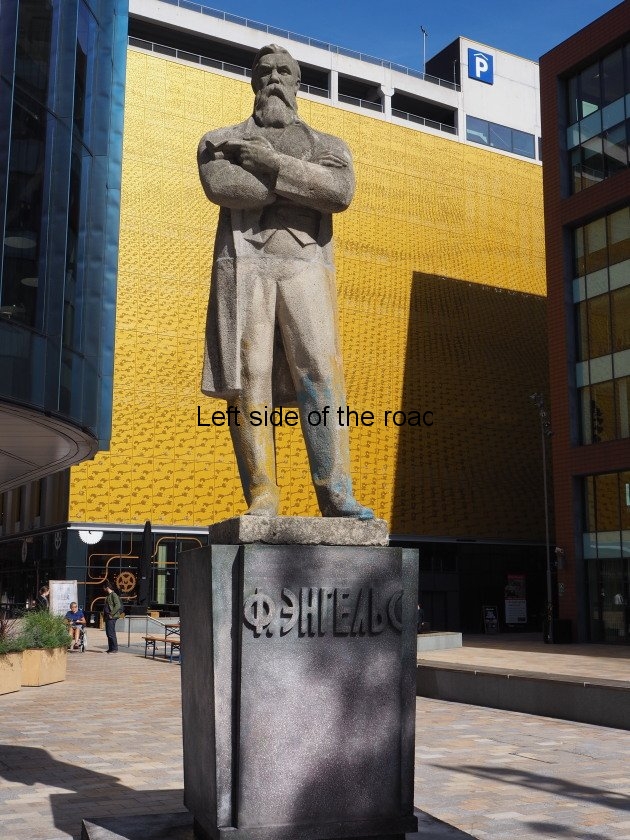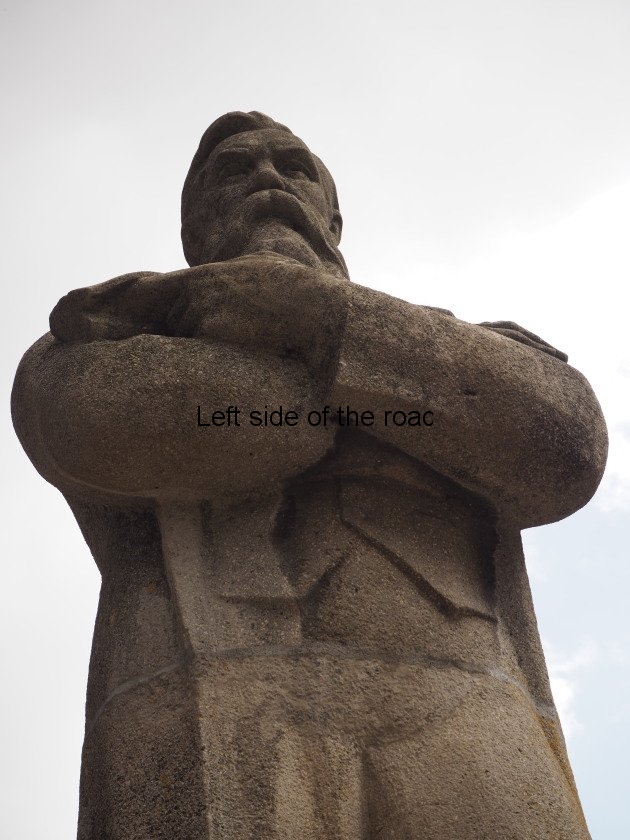
Frederick Engels in Manchester
Karl Marx and Frederick Engels Collected Works
Frederick Engels – pamphlets, books and commentaries
The Great ‘Marxist-Leninist’ Theoreticians
Frederick Engels in Manchester
Frederick Engels – revolutionary fighter, philosopher, close comrade-in-arms of Karl Marx – has returned to Manchester. Almost 150 years since he worked in the city (and thereby being able to support Marx in his development of the theory of the working class that later became known as Marxism) and almost 125 years since his death in 1895 a statue now stands in a pedestrianised square in the city which is considered to be one of the ‘cradles of the industrial revolution’.
Life and work
Engels first went to Manchester in 1842 – and stayed for two years. During that time he produced the unique and seminal work The Condition of the Working Class in England which was published in 1844 – but only in German. It was not available in an English translation until the end of the 19th century in 1885.
But Engels was not an armchair revolutionary – something that is very often forgotten when his role in revolutionary Socialism is discussed. To confine Engels’ role in the development of Marxism to that of someone who; bank-rolled Marx during his (many) times of penury; was able to write penetrating and interesting studies on a diverse range of subjects such as the living conditions of the poor and the role of dialectics of nature; and the only person who could have brought Marx’s most important work (Capital – in all its four volumes) through to publication is to deny what made him able to do all that. Engels was first and foremost a revolutionary fighter, prepared to place his life on the line with other revolutionaries on the barricades of Europe when the workers rose up against oppression and exploitation in 1848.
That revolution ended in failure but Engels and Marx were two of the few who considered what had happened and attempted to work out the lessons of that failure to avoid them in the future. What was later to become the book Germany: Revolution and Counter-revolution first appeared as a series of articles in 1851. Mainly written by Engels (in Manchester), but in close collaboration with Marx (in London) this was an analysis of the failed German revolution which is a companion piece to Marx’s The 18th Brumaire of Napoleon Bonaparte about that situation in France, which was published at around the same time. And in the 1860’s he refined some of his military ideas and tactics in a series of articles that were published in the Manchester Guardian – something which wouldn’t happen now in such a ‘liberal’ newspaper.
It was after the defeat of the revolutions in Europe – Britain had seen some scuffles but never on the scale that ran through many European countries in 1848 – that Engels returned to London and then, the following year, to Manchester where he spent the best part of the next 20 years, working in a family owned textile mill. The monies from this work, and the proceeds of the eventual selling of his part in the partnership in 1869, helped pay for Marx’s living expenses as well as supporting various proto-revolutionary organisations existing in Britain at the time.
After Marx’s death in March 1883 it was Engels who ensured that the culmination of all of Marx’s life and study was to see the light of day, with Engels organising Marx’s notes into a coherent structure and then publishing them as the various volumes of Capital. No one but Engels could have done that work.
By this time Engels had moved to London and he died there in August 1895.
The Statue
The statue was originally erected in the town of Mala Pereshchepyna, in the Poltava region of Eastern Ukraine, in the 1970’s. Sometime in the 1990s it became a victim of the nationalistic counter-revolution and after being vandalised (by being daubed in blue and yellow paint – the colours of the Ukrainian nationalists) it was taken from its plinth, in a central location, and eventually found itself, in two parts, laying in a farmer’s field on the outskirts of the town.
There it lay for a couple of decades before being ‘discovered’ by British artist Phil Collins who was looking for a piece of Socialist Realist sculpture to be placed in Manchester, at the end of the city’s International Festival in August 2017, to stand as a celebration of the city and its people’s radical past – and future? A statue of Frederick Engels was ideal for this due to the time he spent in the city in the 19th century and the input he was able to make towards Marxist ideology through the knowledge he gained from studying the struggle and conditions of the industrial working class in the north-west of England.
The statue is made of a sandy coloured limestone and stands about 3 metres tall. There’s evidence of a join just about waist height. This is so precise it would seem to indicate that the original statue was made in two parts and then cemented together on installation in Mala Pereshchepyna. (It’s too precise a join to have happened when the statue was dismantled by the counter-revolution – there would have been no care used at that time.) Engels stands on a base about 10 cms thick of the same coloured stone.

Ф ЭНГЕЛЬС
The statue is raised above the ground by a plinth about 1.5 metres high which is faced with grey limestone and on one face, that in the direction where Engels is looking, is his name in Cyrillic, Ф ЭНГЕЛЬС = F Engels. Whether the name came from the original location is unlikely – finding the statue was one thing also finding a large piece of worked stone which would have other uses at the same location seems to stretch credibility somewhat. But it doesn’t look new so I assume from another deposed statue of Frederick.
Generally the stone is in a good condition. There are some indications of lichen but considering how it was ‘stored’ nothing serious. Apart from signs of blue and yellow paint around the lower legs, and on the lower edge of his coat on the left, there doesn’t appear to be any other structural damage. Once taken down from its original site it just seems to have been ignored.

Frederick Engels – vandalism
Engels is depicted when he was in his mid to late 50s – he has a full beard and moustache and a full head of hair. He’s dressed in the typical dress of someone with a certain amount of affluence in the late 19th century – formal trousers and a waistcoat over which is a knee-length frock coat with a high collar.
He stands upright, feet slightly apart and is looking straight ahead. His arms are folded across his chest (right arm under the left) and in his left hand he holds a small book, with the forefinger inside the closed book which rests against his right upper arm.

Frederick Engels
Here we get the impression that he has just read something that had caused him to pause, to think of what it might mean, of how important it might be to the project he is currently pursuing. This is reinforced by the pensive look on his face. The finger in the book is to ensure that he doesn’t lose his place when he returns to reading.
The present location is somewhat incongruous. All the buildings around the square are glass and steel monstrosities and something made out of ancient stone does clash with its surroundings. But better here than nowhere.

Frederick Engels – location
It will be interesting to see how the statue is accepted as it spends more time in its new location. Some will know of Engels’ relationship with the city, others will walk by and not even notice any statue there. Matters aren’t made any easier as there is no explanation (not that I think there should be) and for those who don’t understand the Cyrillic alphabet the letters on the plinth don’t offer any help.
(For those who might have been following the posts on Albanian lapidars they might be interested to know that there were never any open air public statues to either Marx or Engels in Socialist Albania. Capitalist Britain now has one of each – Engels in Manchester and the bust of Marx over his grave in Highgate cemetery in London.)
Other Works of Frederick Engels
Here are links to versions of some other of the works produced by Engels over his life time – but it’s important to remember that this list is not definitive.
Principles of Communism – the precursor to the Manifesto.
Communist Manifesto – the general principles of Marxism published in 1848
The Housing Question – the impossibility of the lack of adequate housing for workers being resolved under capitalism
The Part Played by Labour in the Transition from Ape to Man – Engels’ contribution to evolutionary theory with an emphasis on the part that labour played in that evolution
Anti-Duhring – an attack on early revisionism of Marxist theory
Socialism: Utopian and Scientific – a re-statement of the revolutionary aspect of Marxism
The Origin of the Family, Private Property and the State – a look at how society arrived from tribalism to capitalism
Ludwig Feuerbach and the end of Classical German Philosophy – an account of how Marxism found inspiration in Hegelian philosophy, but then left it behind
Location:
Tony Wilson Square, (outside the main entrance to the Home Arts Centre), Manchester, M15 4FN.
GPS:
53.473403
-2.246982
Karl Marx and Frederick Engels Collected Works
Frederick Engels – pamphlets, books and commentaries
The Great ‘Marxist-Leninist’ Theoreticians



























Thank you, Michael! We can say that Egels came back to his historical motherland from the place where he was worshiped as a new god and then went in exile when the masses found a different g-d to worship. I am glad for him and for the work of art and for the artist, whose impressive creation found a place, which he probably did not see even in his dreams. One more life’s twists.
Great write-up. Greetings from Adam